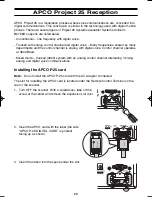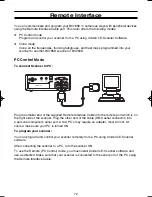
60
Lists. The powerful AFS Partial Entry feature designed into the BC785D lets you use either a
complete talkgroup code, or just the most significant part.
This feature lets you expand or narrow searching and
scanning to one of 4 levels. By entering only the desired part
of an AFS talkgroup, you can select 2048 talkgroups,
128 talkgroups, 8 talkgroups, or a single talkgroup.
For example, you could program every talkgroup in a police
department with just 4 key presses. You can use the AFS
Partial Entry feature anywhere that you need to specify
EDACS talkgroup.
Your BC785D can also enter or display EDACS talkgroups in decimal format (0-2047).
Select
2:SCAN OPTION
/
2:TRUNK
- select bank number /
:EDCS ID FORM
by
rotating the
VFO
and pressing
E
. And change it to
2:DECIMAL
and press
E
. You can use
this feature to translate decimal talkgroups lists to the much more powerful AFS format.
☞
Remember! You can also use
▲
or
▼
instead of rotating the
VFO
.
Also instead of pressing
E
, you can press the
VFO
control.
Examples of how you might use AFS are shown above in the description of an EDACS
trunked system, and elsewhere in this manual. It is very easy to use. Be sure to become
familiar with AFS Partial Entry, and your scanning will become far more flexible and efficient.
Emergency Call Alert
Your BC785D alerts you when an EDACS Emergency transmission occurs.
EDACS systems often provide users with an 'Emergency' mode on their radios. Users in
trouble can alert the dispatcher and other units and get priority access to the radio system.
When a user activates Emergency mode,
EMERGENCY
will flash the display during the
entire transmission. At the beginning of each transmission it will sound a distinctive
emergency alert tone three times. To turn Emergency Alert ON/OFF, enter into the Menu
mode. Select
2:SCAN OPTION
/
2:TRUNK
- select Bank number -
0:EMERGENCY
ALT
/
1:ON
or
2:OFF
by rotating the
VFO
and pressing
E
.
Patch Tracking
The BC785D can follow EDACS patched talkgroups.
EDACS systems sometimes bring several talkgroups together in a 'Patch'. A patch might be
used by a police agency at night to provide a single channel with a single dispatcher for a
wide area. A patch is created when a single, temporary talkgroup substitutes for the original
talkgroups. While the patch is running, which may be for hours or days, the original
talkgroups cease to be used. If you were monitoring one of these talkgroups, you might think
there was no traffic, but in fact the talkgroup was operating at the different temporary
number.
If a talkgroup in your Scan List is patched, your scanner will continue to receive it under its
new identity until the patch has ended. When a patch is being received, the radio will display
PATCH ID
, and will show the temporary common talkgroup plus all the included
talkgroups in a cycling display. The BC785D is limited to following one patches.
The temporary talkgroups used for patches are usually found in AFS code 15-xxx, and
sometimes 00-xxx.
BC785D 11/8/2 1:01 PM Page 60
















































